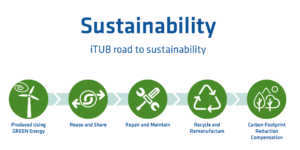Our business model is based on the principles of the circular economy where multiuse systems are generally preferred over singular or single-use systems. The circular economy aims to minimize waste, maximize resource efficiency, and create a regenerative system where materials and products can be used for as long as possible.
These are some of the benefits of creating tubs that are fully recyclable, sharable, repairable, and usable for up to 12-15 years;
- Resources Conservation: Multiuse systems help conserve natural resources by extending the lifespan of products and materials. Instead of using resources to create new items for every use, multiuse systems promote reuse and repair, reducing the need for raw material extraction and production.
- Waste Reduction: By using products and materials multiple times, multiuse systems reduce waste generation. Instead of discarding items after a single use, our tubs are designed to be durable, repairable, and adaptable resulting in less waste going to landfills or incineration. In fact, all our tubs are fully recyclable.
- Energy and Cost Saving: Multiuse systems can lead to significant energy and cost savings compared to single-use systems. When products are reused, it reduces the energy required for manufacturing the items and the associated costs. It also reduces the need for transportation and other resources used the in the production and distribution of single-use items.
- Reduced Environmental Impact: Multiuse systems help reduce the environmental impact associated with the extraction, production, and disposal of materials. By extending the lifespan of products, multiuse systems decrease greenhouse gas emissions, water consumption, and other environmental burdens.
- Consumer Satisfaction and Engagement: Multiuse systems can provide consumers with more sustainable and affordable options. Offering products and services that promote durability, repairability, and customization promotes consumer satisfaction and engagement by giving greater control and involvement in the product lifecycle.







